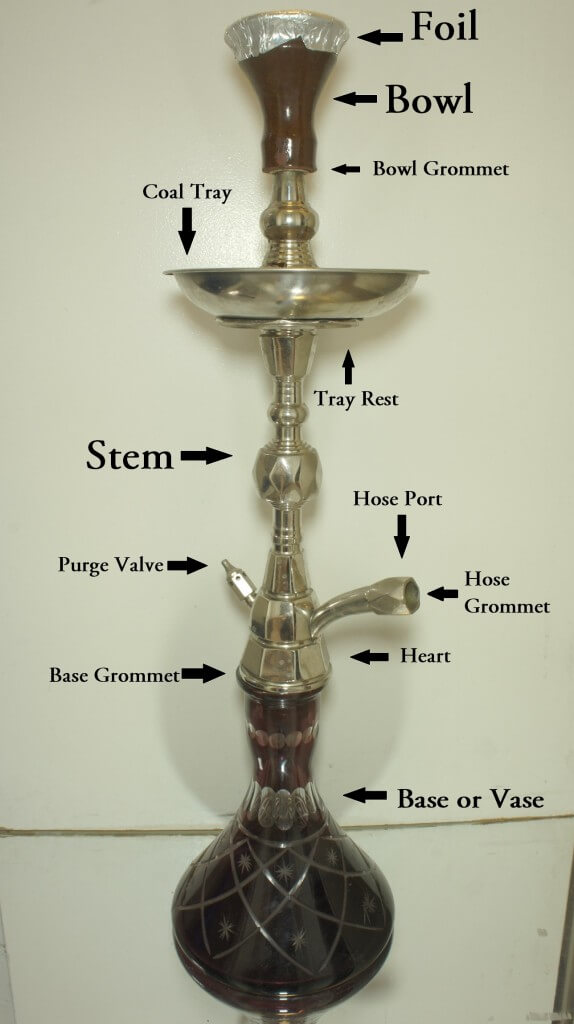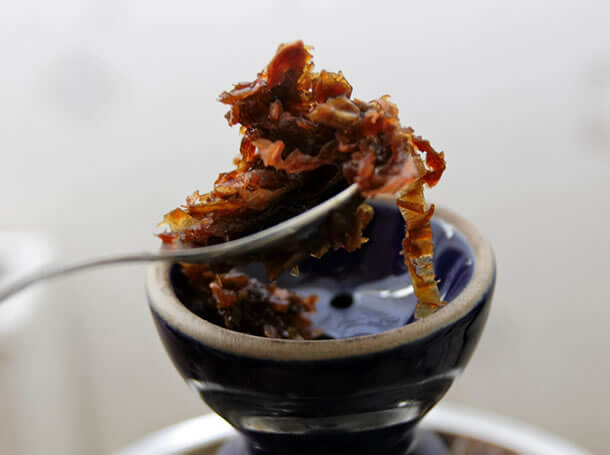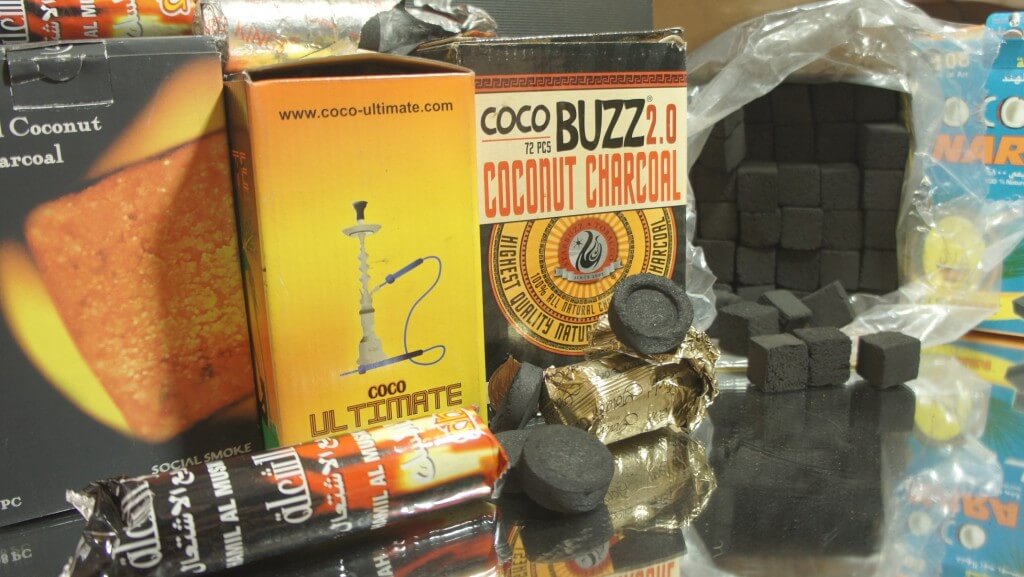I’ve come to realize that even though we have a lot guides on this website we do not have a general beginner hookah. Everyone needs to start somewhere and I’d like to introduce you to our favorite smoking device. This is Hookah 101 and if you scroll a little down you’ll see a picture of it too.
It’s a smoking pipe that uses water to cool and filter the tobacco smoke before it reaches your lips. The tobacco used in a hookah come in a variety of flavors including fruits, spices, mixed drinks, candies, desserts but can also be very traditional tobacco similar to the flavor of a spicy cigar. If that sounds interesting you should read on and learn a bit more. Smoking of any kind can be unhealthy and making the decision to partake should be done after becoming well informed.
All the Hookah Parts
Bowl – Also known as the head of the hookah, this can be made from clay, ceramic, metal, glass and even silicone. Clay bowls are by far the most common and are considered to be the best by most traditional smokers.
Bowl grommet – This keeps the bowl firmly seated and stable while blocking out fresh air. Silicone and heat resistant rubber are the most common modern versions.
Coal Tray – This serves as a place to ash your coals and helps prevent dropped coals and stray sparks.
Tray Rest – Very simply, it is a platform upon which your coal tray rests. Some trays sit loose as is common with Egyptian hookahs, some fit snug and others are screwed on. Some trays are a permanent part of the stem and there is no tray rest to speak of.
Stem – The main body of the hookah that has all of the major components. You can switch out hoses, bases and bowls but it’s the stem that makes the hookah. In the center of the stem is a pipe through which the smoke will travel from the bowl and into the base. A hose port sits next to the stem and lets you draw smoke through the hookah.
Purge Valve – Not every hookah has a purge valve but most modern hookahs will. It’s a simple one way valve that allows you to blow into the hose and urge the vase of stale, burnt or unpleasant smoke. The water prevents the smoke from going up the stem and the purge valve offers it an exit (how to unstuck a stuck purge valve).
The Heart – The part of the stem where it meets the vase, marks the transition from stem to down stem and houses the purge and hose port.
Base grommet – Another seal that keeps the system closed and leak free. It is the junction between the stem and vase.
Hose Port – Sitting alongside the main tube of the stem and extends a short distance into the vase, this is where your hose connects to the hookah. The short end of the hose goes into the port and allows you to draw from the smoke in the vase.
Hose Grommet – A rubber or silicone gasket that keeps the hose seated firmly in the port and blocks out air. You get the idea at this point (make hookah grommet with paper towel)
Hose – A flexible hose that connects to the hose port and allows for easier more relaxed smoking. Most often the hose consists of three major parts. A small tip that goes into the hose port, a flexible middle section, and a mouthpiece.
Vase – Most often made of glass, this is where you put your water. It’s nothing special. You don’t need something fancy so long as it can hold water, offers a stable base for your rig and fits your stem properly to create a good seal.

Shisha Tobacco
The most common substance smoked through a hookah is tobacco soaked in a combination of molasses/honey, glycerin and flavorings. Sometimes called “shisha” but that’s a misnomer. Shisha is another name for hookah and actually translates to glass or bottle. There are also tobacco free alternatives like herbal options and entirely fruit mixtures that contain no nicotine. There are a lot of options but the most abundant and popular is tobacco.

Hookah Charcoal
There are many different style of charcoal but they are all carbonized plant matter most often hardwood, fruit wood or coconut shells. Never use BBQ charcoal briquettes. They produce toxic gas and can be dangerous. To be safe, only use high quality charcoal designed to be used for hookah smoking.
- Quick light charcoal is coated in chemicals like gun powder and allows you to start the charcoal with a flame as small as a match or cigarette lighter. Those chemicals can cause off flavors in the smoke and headaches in some people. They are very popular for their convenience (see Three Kings and Belgian coals) and because they are the most common charcoal found in smoke shops.
- Natural charcoal has no starter chemicals and must be started on an open flame or coil burner. They take longer to light than QL coals but have less chemicals, produce less flavor, cause less headaches, burn a little cooler and last longer. They are also cheaper than QL coals and last longer, so they are more cost efficient in both the short and long term (see Coco Naras, Coco Buzz, and Coco-Ultimate)
Make sure to check out our in depth charcoal guides and videos for more detail on the different type of charcoal available.

Foil
While some people like screens, the most common barrier between the coals and tobacco is aluminum foil. The foil keeps the heat indirect and allows you to vaporize the molasses/honey, glycerin, nicotine and flavorings without burning anything. You can use an aluminum foil or a metal screen.
Water
Water is the most common and most classic liquid to use in the base of your hookah. Just about any liquid you can drink can be used in the base and some will even add a little flavor but most are a waste and can even damage your hookah. Water is the way to go (also see how much water to put in your base).
Once you have all of this gathered together it’s time to move onto the next step. Make sure to check out Part 2: Putting it All Together.
